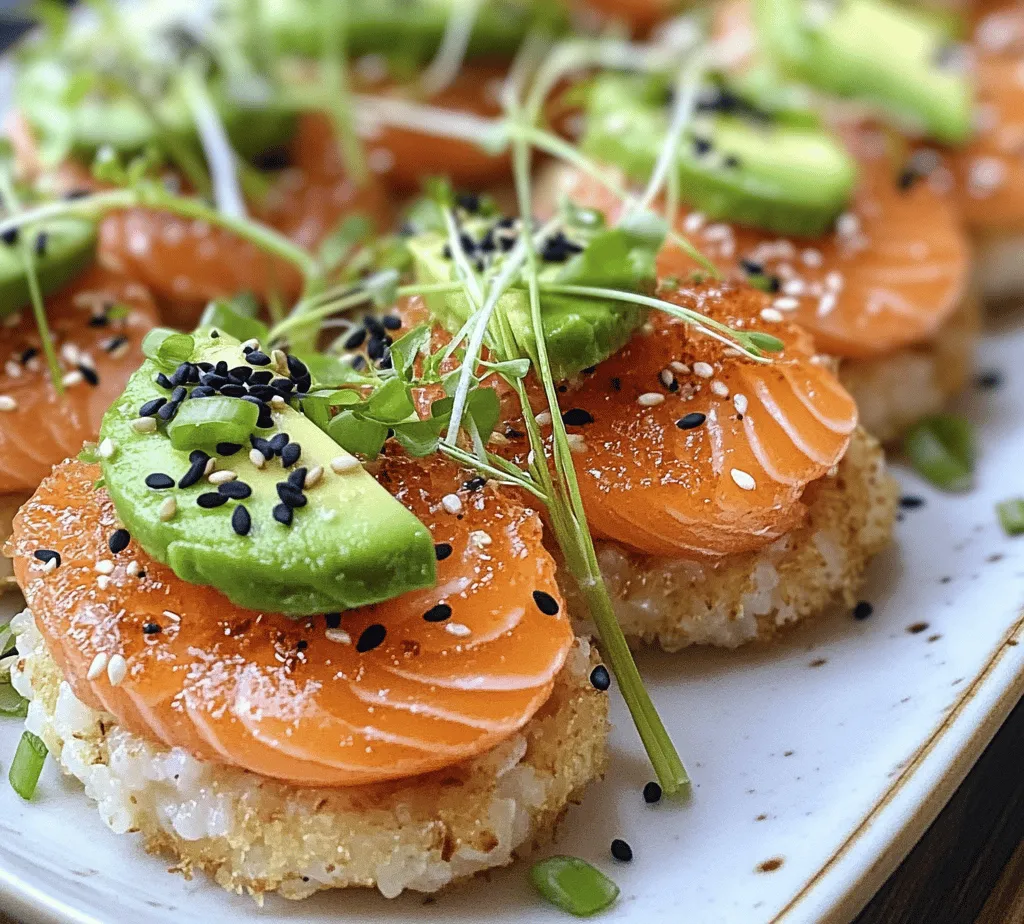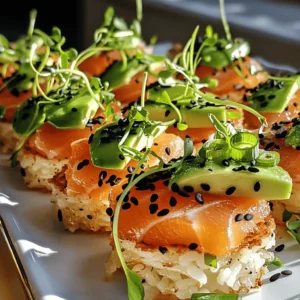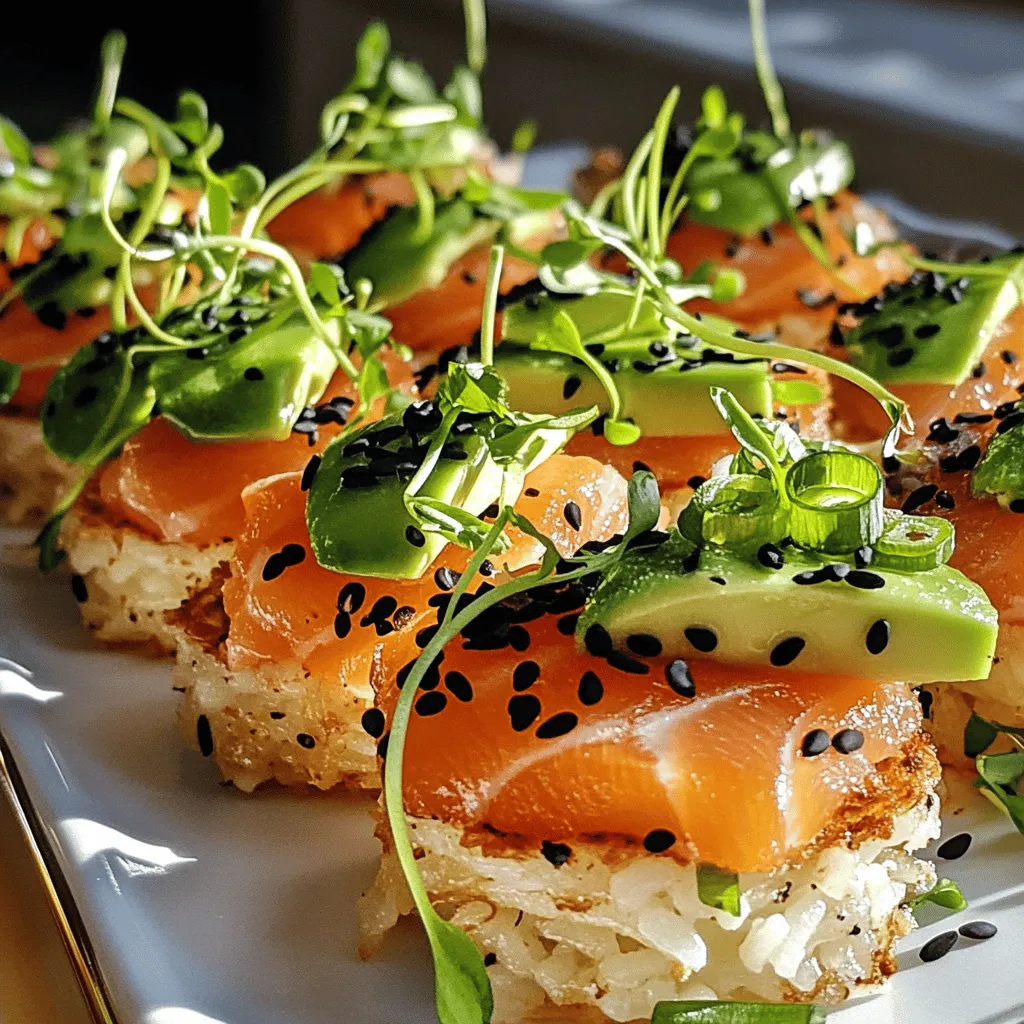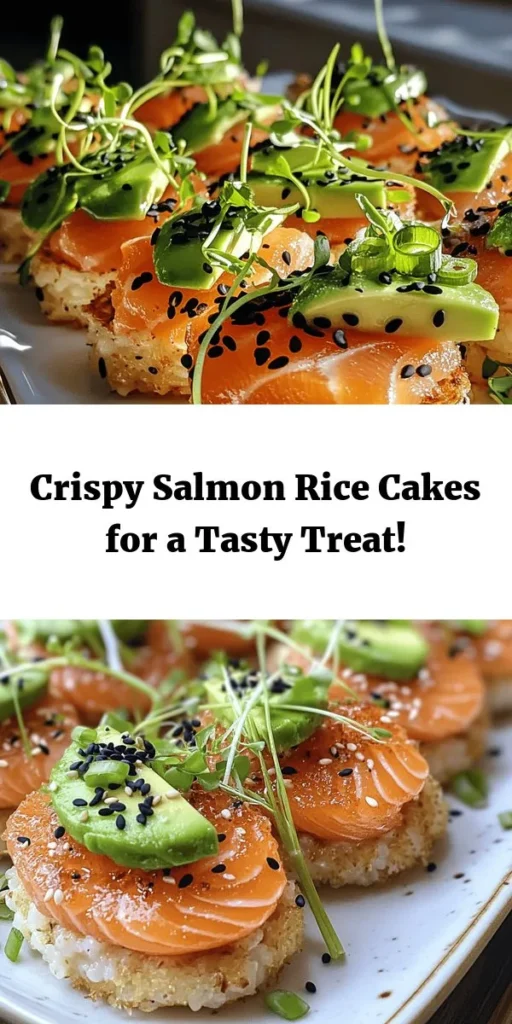Introduction
In recent years, sushi-inspired dishes have taken the culinary world by storm, captivating food lovers with their unique blends of flavors and textures. Among these delightful creations, Salmon Crispy Rice stands out as a true masterpiece. This dish marries the freshness of sushi with the satisfying crunch of crispy fried rice cakes, creating a sensational experience for your taste buds.
What makes Salmon Crispy Rice particularly appealing is its combination of crispy textures and fresh, high-quality ingredients. The crunchy rice base serves as the perfect canvas for the succulent salmon and refreshing toppings, making every bite an explosion of flavor. Whether you’re hosting a casual gathering with friends or planning an elegant dinner party, this versatile dish is sure to impress your guests and elevate any occasion.
The beauty of Salmon Crispy Rice lies not only in its taste but also in its presentation. The vibrant colors of the salmon, avocado, and garnishes create a visually stunning dish that will have everyone reaching for their phones to snap a picture before diving in. With its intriguing combination of flavors and textures, it’s no wonder that Salmon Crispy Rice has become a favorite among food enthusiasts and home cooks alike.
Understanding the Key Ingredients
To create the perfect Salmon Crispy Rice, it’s essential to understand its key ingredients, starting with sushi rice. Sushi rice is a short-grain rice known for its sticky texture and slightly sweet flavor, which makes it ideal for sushi preparations. This type of rice absorbs flavors well and holds its shape, making it perfect for forming into rice cakes.
Choosing the Right Type of Rice
When selecting sushi rice, it’s important to choose high-quality, short-grain varieties such as Japonica rice. This type of rice is characterized by its plump grains that become sticky when cooked, allowing them to clump together without losing their individual texture. Using long-grain rice or other varieties will not yield the same results and can lead to a subpar dish.
Tips for Rinsing and Preparing Sushi Rice
Rinsing sushi rice is a crucial step in the preparation process. This removes excess starch that can make the rice gummy. To rinse sushi rice effectively, place it in a fine-mesh strainer and run it under cold water. Gently agitate the rice with your fingers until the water runs clear. This process helps to ensure the grains remain separate and achieve the perfect texture when cooked.
After rinsing, it’s essential to soak the rice for about 30 minutes before cooking. This allows the grains to absorb moisture, leading to a more even cooking result. When cooking sushi rice, a typical water-to-rice ratio is 1:1.2, which means you should use 1.2 cups of water for every cup of rice. This ratio may vary slightly depending on your cooking method, so it’s essential to follow the guidelines from your rice cooker or pot instructions for the best results.
Exploring Sushi-Grade Salmon
The next star ingredient in Salmon Crispy Rice is sushi-grade salmon. This high-quality fish not only enhances the overall flavor of the dish but also contributes to its visual appeal. Sushi-grade salmon is sourced from reputable suppliers and is safe to consume raw, making it a top choice for sushi lovers.
What to Look for When Selecting Salmon
When selecting sushi-grade salmon, look for fish that is bright in color, with a firm texture and no unpleasant odor. Freshness is paramount, so always purchase salmon from a trusted fishmonger or grocery store specializing in seafood. If you’re unsure, don’t hesitate to ask the staff about the fish’s origin and handling practices.
The benefits of using high-quality fish in sushi preparations cannot be overstated. Fresh salmon not only elevates the dish’s flavor but also ensures a safe and enjoyable dining experience. When prepared correctly, sushi-grade salmon can melt in your mouth, providing a delightful contrast to the crispy rice.
Importance of Fresh Toppings
In addition to sushi rice and salmon, fresh toppings play a significant role in the overall flavor and texture of Salmon Crispy Rice. One of the most important toppings is avocado. The creamy texture of ripe avocado beautifully complements the rich flavor of salmon, adding a layer of indulgence to each bite.
Overview of Garnishes
To elevate the dish further, consider garnishing your Salmon Crispy Rice with green onions, nori (seaweed), and microgreens. Green onions add a mild onion flavor and a pop of color, while nori provides a subtle umami taste and a hint of ocean freshness. Microgreens, on the other hand, bring an element of elegance to the dish, enhancing its visual appeal and contributing additional nutrients.
By carefully selecting and preparing these ingredients, you set the foundation for a truly remarkable Salmon Crispy Rice experience.
Step-by-Step Guide to Making Salmon Crispy Rice
Now that we’ve covered the essential ingredients, let’s delve into the step-by-step process of making Salmon Crispy Rice. This guide will walk you through each stage, ensuring that you create rice cakes with the perfect texture and flavor.
Cooking the Sushi Rice
The first step in creating Salmon Crispy Rice is cooking the sushi rice. This step is fundamental, as the quality of the rice directly impacts the final dish.
Importance of Rinsing the Rice for Better Texture
As mentioned earlier, rinsing the rice is crucial for achieving a fluffy texture. By removing excess starch, you ensure that the rice cooks evenly and holds together when formed into cakes. Once the rice is rinsed and soaked, it’s time to cook it.
Instructions for Using the Correct Water-to-Rice Ratio
Using the right water-to-rice ratio is essential for perfect sushi rice. Typically, a ratio of 1.2 cups of water for each cup of rice works well. If you’re using a rice cooker, simply follow the manufacturer’s instructions. If you’re cooking on the stovetop, bring the water to a boil, then reduce the heat to low, cover, and simmer for about 18-20 minutes. Avoid lifting the lid during this time to prevent steam from escaping.
Explanation of the Cooking Process and Resting Phase
Once the rice is cooked, remove it from the heat and let it rest for an additional 10 minutes with the lid on. This resting phase allows the rice to finish cooking through residual heat and helps it achieve the desired sticky consistency.
Seasoning the Rice
After resting, it’s time to season the rice to enhance its flavor. The seasoning will bring out the natural sweetness of the rice while adding a tangy note.
Role of Rice Vinegar and Sugar in Flavoring the Rice
The traditional seasoning for sushi rice consists of rice vinegar, sugar, and salt. The rice vinegar adds acidity, balancing the sweetness of the sugar and the salinity of the salt. For every cup of uncooked rice, you typically use about 2 tablespoons of rice vinegar, 1 tablespoon of sugar, and a pinch of salt.
Once your seasoning mixture is ready, transfer the cooked rice to a large bowl. Pour the seasoning evenly over the rice and gently fold it in using a spatula.
Tips for Folding in the Seasoning Without Mashing the Rice
It’s essential to fold the seasoning into the rice gently to avoid mashing the grains. Use a cutting motion to lift the rice and fold it over itself, ensuring even distribution of the seasoning while keeping the rice’s texture intact.
Forming the Rice Cakes
With seasoned sushi rice in hand, it’s time to form the rice cakes that will serve as the base for your Salmon Crispy Rice.
Techniques for Shaping Rice Cakes
To shape the rice cakes, you’ll want to ensure that your hands are slightly moist to prevent sticking. Take a handful of the seasoned rice and gently squeeze it together to form a compact cake. Aim for a thickness of about 1 inch and a size that will easily fit in your frying pan.
Once the rice cakes are formed, place them on a plate lined with parchment paper to keep them from sticking. Repeat the process until all the rice is shaped into cakes.
Importance of Moisture in Hands to Prevent Sticking
Keeping your hands moist is crucial during this step. Not only does it prevent the rice from adhering to your skin, but it also helps maintain the integrity of the rice cakes, ensuring they stay together during frying.
With the rice cakes formed and ready to go, you are now one step closer to creating your delicious Salmon Crispy Rice. In the next section, we will explore the frying process, essential for achieving that irresistible crispy texture that makes this dish so special.
Stay tuned as we dive deeper into the culinary experience of making Salmon Crispy Rice, ensuring that your dish is not only delicious but also a feast for the eyes.

Ideal Size and Thickness for Crispy Cakes
When preparing Salmon Crispy Rice, the size and thickness of the rice cakes play a crucial role in achieving the perfect texture. Ideally, each rice cake should be about 2 to 3 inches in diameter and approximately 1/2 inch thick. This size allows for a perfect balance between a crispy exterior and a soft, chewy interior. If the cakes are too thin, they may burn easily; if they are too thick, they may not achieve that delightful crunch.
Frying the Rice Cakes
Frying is where the magic happens, turning your prepared rice cakes into the crispy delights that will serve as the base for your salmon topping.
Detailed Frying Instructions for Achieving the Perfect Crispiness
1. Heat the Oil: In a large skillet or frying pan, pour enough vegetable oil to cover the bottom in a thin layer—about 1/4 inch deep. Heat the oil over medium-high heat until it shimmers but is not smoking. This typically takes around 5 minutes.
2. Test the Temperature: To ensure the oil is ready, drop a small piece of rice into the oil. If it sizzles immediately, you’re good to go. If it browns too quickly, reduce the heat slightly.
3. Add the Rice Cakes: Carefully place the rice cakes in the hot oil, ensuring there is enough space between them. Overcrowding the pan can lower the oil temperature, resulting in soggy cakes rather than crispy ones.
4. Fry Until Golden Brown: Cook the rice cakes for about 3-4 minutes on one side. Watch for visual cues: the edges will begin to turn golden brown, and you should see a satisfying crisp forming.
5. Flip with Care: Use a spatula to gently flip each cake. If they stick, give them a little more time before attempting to turn them. Fry the other side for an additional 2-3 minutes until golden brown.
6. Drain Excess Oil: Once cooked, transfer the rice cakes to a paper towel-lined plate to absorb any excess oil. This step is essential to maintain their crispiness.
Importance of Oil Temperature and Avoiding Overcrowding
Maintaining the correct oil temperature is vital. If the oil is too cool, the rice cakes will absorb excess oil and become greasy. Conversely, if the oil is too hot, the cakes may burn before cooking through. Keeping an eye on the temperature and frying in batches will yield the best results.
Visual Cues for Knowing When to Flip the Cakes
Keep an eye on the edges of the rice cakes. When they start to turn golden brown and you can see a slight bubbling around the edges, it’s a good indication that it’s time to flip them. Additionally, they should release easily from the pan when they’re ready to be turned.
Preparing the Salmon Topping
While the rice cakes are frying, it’s time to prepare the salmon topping that will elevate this dish.
Mixing Salmon with Soy Sauce and Sesame Oil for Flavor
1. Select Quality Salmon: Choose fresh, sushi-grade salmon for the best flavor and texture.
2. Dice the Salmon: Using a sharp knife, slice the salmon into thin, bite-sized pieces. Aim for uniformity to ensure even marinating.
3. Mix the Marinade: In a medium bowl, combine 2 tablespoons of soy sauce and 1 tablespoon of sesame oil. This combination will enhance the salmon’s natural flavors.
4. Combine and Marinate: Gently fold the diced salmon into the marinade, ensuring every piece is coated. Let it sit for about 10 minutes to soak in the flavors.
Optional Addition of Wasabi for Those Who Enjoy Spice
For those who appreciate a bit of heat, adding a small amount of wasabi paste to the marinade can elevate the dish. Start with half a teaspoon and adjust according to your spice tolerance. Mix well to incorporate.
Tips for Slicing Salmon Thinly for Presentation
– Use a Sharp Knife: A sharp knife will give you cleaner cuts.
– Chill the Salmon: Refrigerating the salmon for about 30 minutes before slicing helps firm it up, making it easier to cut thinly.
– Cut Against the Grain: For a tender bite, always slice against the grain of the salmon.
Assembling the Dish
Now that both the rice cakes and salmon are ready, it’s time to bring the dish together.
Layering Components for Optimal Flavor and Visual Appeal
1. Place the Rice Cakes: Start with your crispy rice cakes as the base. Arrange them on a serving platter or individual plates for a beautiful presentation.
2. Top with Salmon: Spoon the marinated salmon generously on top of each rice cake. Make sure to distribute the salmon evenly for a balanced flavor in every bite.
3. Garnish: Consider garnishing with finely sliced green onions, sesame seeds, or microgreens for an added pop of color and flavor.
Importance of Presentation in Enhancing the Dining Experience
A well-presented dish not only looks appetizing but also enhances the overall dining experience. The contrast between the golden-brown rice cakes and the vibrant pink salmon creates an enticing visual appeal that will impress your guests.
Creative Ideas for Variations on Toppings
While the basic salmon topping is fantastic, you can get creative with variations. Consider these ideas:
– Avocado: Add sliced or mashed avocado for creaminess.
– Spicy Mayo: Drizzle with a mixture of mayonnaise and sriracha for added flavor.
– Pickled Vegetables: Top with pickled ginger or radishes for a tangy crunch.
– Tropical Twist: Use mango or pineapple salsa for a refreshing tropical flavor.
Serving Suggestions and Pairings
To enhance the dining experience further, consider these serving suggestions.
Recommended Beverages to Complement Salmon Crispy Rice
– White Wine: A chilled Sauvignon Blanc or a light Pinot Grigio pairs beautifully with the rich flavors of salmon.
– Sake: Choose a Junmai or Ginjo sake for a harmonious match with the dish’s umami notes.
– Non-Alcoholic Options: Sparkling water with a slice of lemon or a refreshing green tea can cleanse the palate effectively.
Ideal Side Dishes to Serve Alongside
To round out your meal, consider serving alongside:
– Fresh Salads: A simple cucumber and avocado salad dressed with rice vinegar complements the dish well.
– Light Soups: Miso soup or a clear broth can provide a comforting contrast to the crispy rice.
Presentation Tips for Serving at Gatherings or Special Occasions
For gatherings, consider serving the Salmon Crispy Rice on a large platter to encourage sharing. Use decorative plates and garnishes to elevate the visual appeal.
Nutritional Benefits of Salmon Crispy Rice
Salmon Crispy Rice is not just delicious; it also offers several health benefits.
Overview of the Health Benefits of Salmon
Salmon is packed with nutrients, including high-quality protein, vitamins, and minerals. It is particularly rich in:
– Omega-3 Fatty Acids: These essential fatty acids have been proven to support heart health and reduce inflammation.
– Vitamin D: A crucial nutrient for bone health and immune function.
– B Vitamins: Important for energy metabolism and brain function.
Nutritional Value of Sushi Rice and Its Role in a Balanced Diet
Sushi rice is not only delicious but also provides a good source of carbohydrates, giving you the energy needed for daily activities. When prepared with a touch of rice vinegar, it aids in digestion and adds a subtle flavor that complements the salmon perfectly.
Discussion on Incorporating More Seafood into Regular Meals
Integrating more seafood into your diet is beneficial for overall health. Aim to include fish in your meals at least twice a week to reap the rewards of omega-3 fatty acids, which may reduce the risk of chronic diseases and promote brain health.
Conclusion
Salmon Crispy Rice is a delightful dish that combines simplicity with elegance. The crispy texture of the rice cakes paired with the rich flavor of marinated salmon creates a memorable culinary experience. Whether you are entertaining guests or enjoying a quiet dinner at home, this recipe is sure to impress.
Don’t hesitate to experiment with your toppings and variations, making this dish your own. Cooking is about creativity and sharing wonderful meals with loved ones, so gather your ingredients and dive into the joy of preparing Salmon Crispy Rice.



